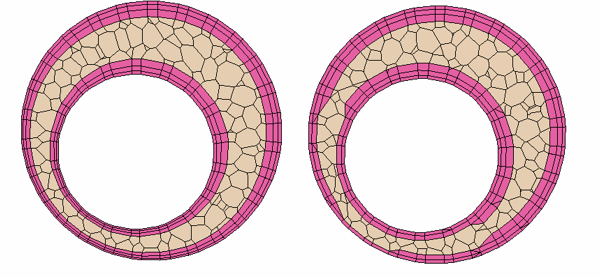What Are the Differences Between the Advancing Layer and Prism Layer Meshers?
The advancing layer and prism layer meshers both produce prismatic cell layers near wall boundaries. However, there are several differences between the meshers that make them suitable for different applications.
The advancing layer mesher generates a polygonal surface mesh from the initial triangulated surface. The prismatic cell layers are then generated by extruding the polygonal surface into the region volume. This approach relaxes the dependency between the subsurface and region topology, and allows the advancing layer mesher to generate a thicker, more uniform layer than the prism layer mesher can achieve.
The advancing layer mesher also collapses and splits faces and edges, which helps to improve mesh quality – particularly when reducing cell skewness.

Another difference between the prism layer and advancing layer meshers is the way that the two meshers behave in narrow gaps. In order to maintain some polyhedral cells between the opposing prism layers, the prism layer mesher can gradually reduce the layer thickness and remove layers. The advancing layer mesher instead removes cell layers without any reduction in thickness. An example where it could be advantageous to use the advancing layer mesher is when using a non-hybrid wall function turbulence model. The advancing layer mesher maintains the first layer thickness to give more control of the y+ value, whereas the prism layer mesher reduces the first layer thickness and the y+ is changed.

If a volumetric control is activated which contains cells that are assigned to the Advancing Layer Mesher, both the polyhedral/tetrahedral core cell size and the prismatic layer cell size are refined. However, when using the Parts Based Meshing (PBM) approach, you can customize prism settings for cells that are assigned to the Advancing Layer mesher using volumetric controls. When using PBM, you can update the selected Optional Boundary Layer Mesher between the Prism Layer Mesher or the Advancing Layer Mesher without losing settings for related default controls settings.
If a volumetric control is activated which contains cells that are assigned to the Prism Layer Mesher, you can customize the number of layers, stretching factor, or layer thickness. To refine the mesh by cell size, activate a volumetric control for the core mesher. The cell size that you set in the volumetric control is applied to the core mesh only.